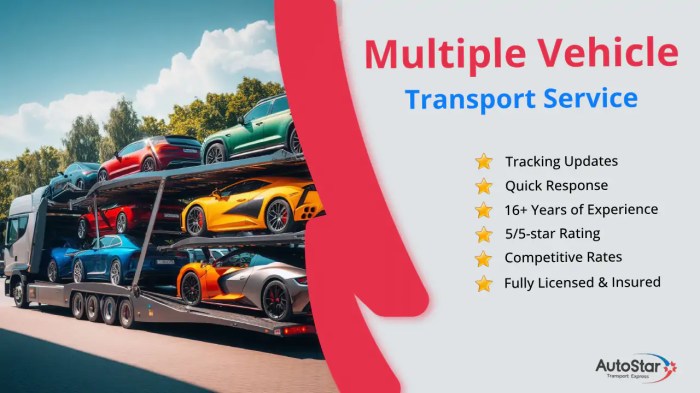Dive into the world of multi vehicle insurance where one policy covers all your vehicles, saving you time and money while ensuring comprehensive protection. Learn about the perks, flexibility, and savings that come with this type of insurance.
What is Multi-Vehicle Insurance?

Multi-vehicle insurance is a type of insurance policy that covers multiple vehicles under a single policy. This means that instead of having separate insurance policies for each vehicle, you can combine all your vehicles (such as cars, motorcycles, or trucks) under one umbrella policy.
How Multi-Vehicle Insurance Differs
Multi-vehicle insurance differs from regular insurance in that it offers the convenience of managing and renewing one policy for all your vehicles. This can save time and paperwork, as well as potentially offer cost savings compared to having individual policies for each vehicle.
- Cost Savings: By bundling multiple vehicles together, insurance companies may offer discounts or lower rates compared to insuring each vehicle separately.
- Convenience: Managing one policy for all your vehicles simplifies the insurance process, making it easier to keep track of payments and renewals.
- Flexibility: Multi-vehicle insurance typically allows you to add or remove vehicles from the policy easily, providing flexibility as your vehicle ownership changes.
Examples of Situations
Multi-vehicle insurance can be beneficial for families with multiple drivers and vehicles, businesses with a fleet of vehicles, or individuals with more than one vehicle. For example:
- A family with two cars and a motorcycle can save money and streamline their insurance by opting for a multi-vehicle policy.
- A business with a fleet of trucks can simplify their insurance management by consolidating all vehicles under one policy.
- An individual with a car for personal use and a motorcycle for recreation can enjoy the convenience of managing both vehicles under a single insurance policy.
Benefits of Multi-Vehicle Insurance
Insuring multiple vehicles under one policy can offer various advantages, including cost savings and additional perks. Let’s explore the benefits in detail:
Cost Savings
- Multi-vehicle insurance often comes with discounted rates compared to insuring each vehicle separately.
- Combining vehicles under one policy can lead to lower overall premium costs, saving you money in the long run.
- Insurers may offer incentives for customers who insure multiple vehicles, making it a cost-effective option.
Convenience and Flexibility
- Managing multiple vehicles under a single policy simplifies the insurance process, reducing paperwork and administrative tasks.
- You can easily add or remove vehicles from the policy, providing flexibility as your vehicle needs change over time.
- Dealing with one insurance provider for all vehicles can streamline communication and claims processes, saving you time and hassle.
Additional Perks and Discounts
- Multi-vehicle policies may come with additional perks such as roadside assistance, rental car coverage, or enhanced protection options.
- Insurers often offer further discounts for safe driving records or bundled insurance products, maximizing your savings.
- You may qualify for loyalty discounts or other special offers by insuring multiple vehicles with the same provider.
Eligibility and Requirements
To be eligible for multi-vehicle insurance, you typically need to meet certain criteria set by insurance providers. This type of insurance is ideal for families or businesses with multiple vehicles that want to streamline their coverage and potentially save on costs.
Types of Vehicles Covered
- Personal vehicles: Cars, SUVs, vans, and motorcycles owned by the policyholder.
- Commercial vehicles: Trucks, vans, and other vehicles used for business purposes.
- Recreational vehicles: Motorhomes, RVs, and trailers used for leisure activities.
Documentation and Information Required
- Vehicle information: Make, model, year, and VIN (Vehicle Identification Number) for each vehicle to be covered.
- Driver details: Names, ages, and driving records of all individuals who will be driving the insured vehicles.
- Prior insurance information: Details of any existing insurance policies on the vehicles, including coverage levels and claims history.
- Policyholder information: Contact details, address, and any other relevant personal information required by the insurer.
Coverage Options
When it comes to multi-vehicle insurance, there are various coverage options available to suit different needs and budgets. Let’s explore the different choices you have when it comes to coverage for multiple vehicles under one policy.
Comparing Coverage Options
- Liability Coverage: This is the most basic form of coverage that is required by law. It helps cover costs if you are at fault in an accident that causes injury or property damage to others.
- Collision Coverage: This helps pay for repairs to your vehicle if it is damaged in a collision with another vehicle or object.
- Comprehensive Coverage: This covers damage to your vehicle from non-collision incidents such as theft, vandalism, or natural disasters.
- Uninsured/Underinsured Motorist Coverage: This protects you if you are involved in an accident with a driver who has insufficient insurance coverage or no insurance at all.
Flexibility in Coverage Levels
- With multi-vehicle insurance, you have the flexibility to choose different coverage levels for each vehicle listed on your policy. This means you can customize the coverage based on the value and usage of each vehicle.
- For example, you may want to have higher liability limits for a newer, more expensive vehicle, while opting for basic coverage for an older vehicle.
Limitations and Restrictions
- It’s important to note that there may be limitations or restrictions in coverage for multi-vehicle insurance. For example, some policies may have a limit on the number of vehicles that can be included under one policy.
- Additionally, certain types of vehicles such as motorcycles, RVs, or commercial vehicles may have different coverage requirements or may not be eligible for multi-vehicle insurance.
Adding and Removing Vehicles

When it comes to multi-vehicle insurance, the flexibility to add or remove vehicles from your policy is essential. Here, we will discuss the steps involved in adding or removing vehicles, any implications on premiums, and how to update information on your policy.
Adding Vehicles
Adding a vehicle to your multi-vehicle insurance policy is a straightforward process:
- Contact your insurance provider and inform them about the new vehicle you wish to add.
- Provide the necessary details about the vehicle, such as make, model, year, and VIN.
- Your insurance provider will adjust your policy to include the new vehicle and provide you with updated documents.
Removing Vehicles
Removing a vehicle from your multi-vehicle insurance policy can also be done easily:
- Contact your insurance provider and let them know which vehicle you want to remove.
- Provide the details of the vehicle being removed, including its make, model, and VIN.
- Your insurance provider will make the necessary adjustments to your policy and update your documents accordingly.
Implications on Premiums
Adding or removing vehicles from your multi-vehicle insurance policy can impact your premiums:
- Adding a high-value or high-performance vehicle may increase your premiums due to a higher risk profile.
- Removing a vehicle that was contributing to a multi-vehicle discount may lead to a slight increase in premiums for the remaining vehicles.
- It’s important to review your policy and discuss any changes in premiums with your insurance provider.
Updating Information and Making Changes
Keeping your policy up to date requires regular updates and changes:
- Notify your insurance provider of any changes in vehicle ownership, address, or drivers listed on the policy.
- Review your policy annually to ensure that it reflects your current situation and needs.
- If you need to make changes to your policy, such as coverage adjustments or adding/removing vehicles, contact your insurance provider for assistance.
Conclusion
In conclusion, multi vehicle insurance offers a convenient and cost-effective solution for insuring all your vehicles under one policy. With various benefits and flexible coverage options, it’s a smart choice for those looking to streamline their insurance needs.